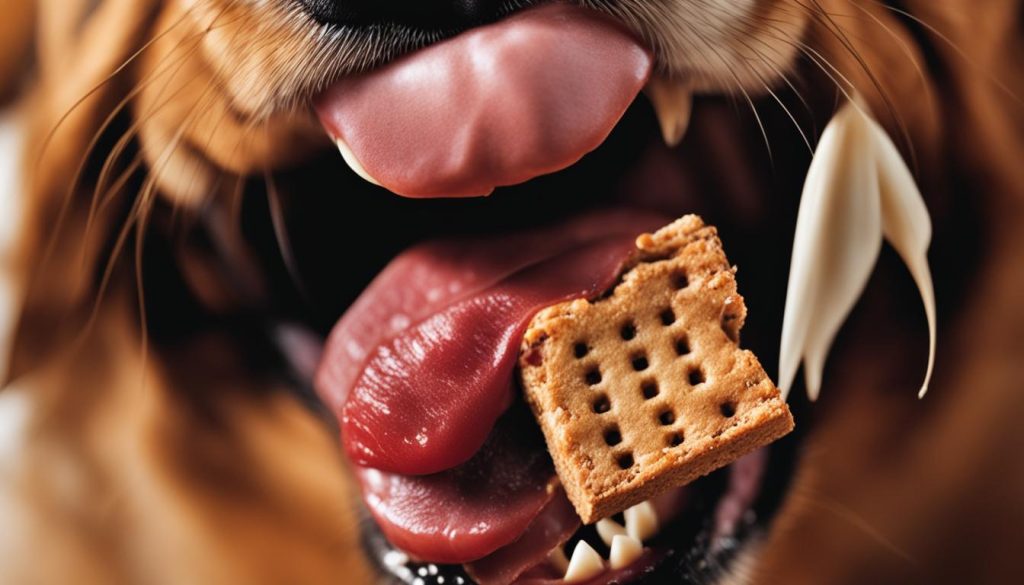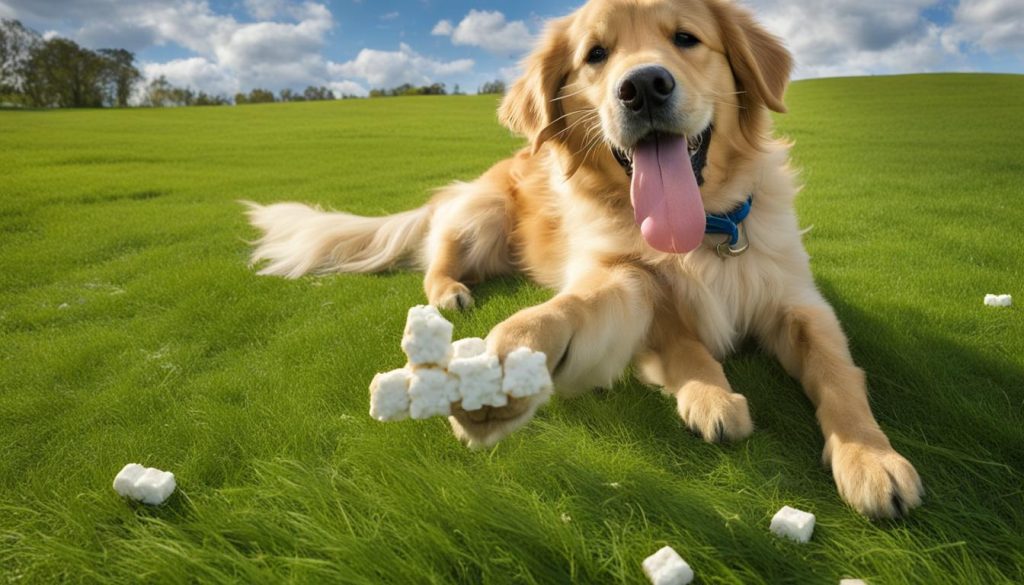As a professional with years of experience in the field of pet nutrition, I am often asked about what human foods are safe for dogs to consume. One such question that frequently arises is whether dogs can eat graham crackers. In this article, I will provide expert guidance and advice on this topic, offering valuable insights into the potential risks and benefits of feeding graham crackers to dogs.
Key Takeaways:
- Graham crackers are safe for dogs to eat in moderation, but they should not be a regular part of their diet.
- Graham crackers are not nutritionally beneficial for dogs and can contribute to weight gain and potential dental issues.
- Honey and cinnamon graham crackers can be given to dogs occasionally, but it is important to consider their calorie and sugar content.
- It is recommended to opt for dog-specific treats that are lower in calories and offer more nutritional value.
- When feeding graham crackers to dogs, it is crucial to monitor portion sizes and be mindful of any potential allergies or sensitivities.
Are Graham Crackers Bad for Dogs?

Graham crackers are generally safe for dogs to eat, but they are not nutritionally beneficial. While they are not considered toxic, they contain ingredients like honey and sugar that are not necessary for a dog’s diet. Feeding graham crackers to a dog regularly can lead to potential health issues.
Graham crackers are higher in calories compared to dog biscuits and other dog-friendly treats. As a result, frequent consumption of graham crackers can contribute to weight gain and obesity in dogs. The sugar content in graham crackers can also be problematic, especially for dogs who are overweight, obese, or have diabetes. It is crucial to prioritize a balanced and nutritious diet for dogs, and graham crackers should be given sparingly as an occasional treat.
When it comes to dental health, graham crackers may pose a risk to dogs. The sugar in graham crackers can potentially contribute to tooth decay and other dental problems in dogs. It’s important to prioritize oral hygiene and provide dental-friendly treats that promote dental health rather than opting for graham crackers which offer little to no benefits in this aspect.
To summarize, while graham crackers are not inherently harmful to dogs, they are not considered good for them either. It is best to reserve graham crackers as an occasional treat and prioritize treats that are specifically formulated for dogs and offer nutritional benefits. Ensuring moderation and mindful treat giving is essential for maintaining the overall health and wellbeing of our furry friends.
Can Dogs Eat Honey Graham Crackers?
Dogs can eat honey graham crackers as an occasional treat. Honey is generally safe for dogs in small amounts, but it’s important to keep in mind that graham crackers with honey are still higher in calories and sugar. While it may be tempting to share this tasty snack with your furry friend, it’s best to offer lower calorie, meat-rich treats to dogs for their overall health and wellbeing. Remember, moderation is key when it comes to feeding graham crackers to your dog.
Instead of honey graham crackers, you can consider other safe alternatives that are more suitable for your dog’s dietary needs. Opt for treats that are specifically formulated for dogs and provide nutritional benefits. Fruits like apple, banana, and berries can be a healthy and safe option for your dog. Additionally, vegetables like zucchini and green beans can also be offered as treats for added variety. These alternatives provide a lower calorie option and can be a more nutritious choice for your dog.
Please be aware that every dog is different and may have individual dietary restrictions or sensitivities. If you’re unsure about whether your dog can safely consume honey graham crackers or any other treats, it’s always best to consult with your veterinarian. They can provide personalized advice based on your dog’s specific needs and ensure that their diet remains balanced and healthy.
| Treat | Calories per Serving | Sugar Content |
|---|---|---|
| Honey Graham Crackers | 120 | 7g |
| Apple slices | 52 | 10g |
| Banana slices | 96 | 17g |
| Berries (such as blueberries or strawberries) | 29-50 | 3-7g |
| Zucchini slices | 20 | 2g |
| Green beans | 31 | 3g |
Quote:
“While honey graham crackers may be a tasty treat, it’s important to be mindful of the calorie and sugar content. Opting for lower calorie, meat-rich treats or fresh fruits and vegetables can provide a healthier alternative for your dog.” – Dr. Amanda, Veterinarian
Can Dogs Eat Cinnamon Graham Crackers?
Cinnamon graham crackers can be a tasty treat for dogs, but it’s important to understand the potential risks and limitations. While cinnamon itself is not toxic to dogs, it’s crucial to ensure that the graham cracker does not contain any harmful ingredients like xylitol, which can be severely toxic to dogs. Therefore, it’s essential to check the ingredient list before offering cinnamon graham crackers to your furry friend.
When giving dogs cinnamon graham crackers, moderation is key. These snacks are typically higher in calories and sugar, which can lead to weight gain, obesity, and potential dental problems if consumed excessively. It’s best to only offer a small portion as an occasional treat and avoid making it a regular part of their diet. Remember, a dog’s nutritional needs are best met with a balanced diet specifically formulated for their needs.
It’s crucial to remember that every dog is different, and what works for one may not work for another. If you’re unsure about whether cinnamon graham crackers are suitable for your dog, it’s always a good idea to consult with your veterinarian. They will be able to provide you with personalized advice based on your dog’s specific dietary needs and health conditions.
While cinnamon graham crackers can be enjoyed by dogs in moderation, it’s important to prioritize their overall health and wellbeing. Opting for dog-friendly treats that are specifically formulated to meet their nutritional needs is a safer and more beneficial choice. If you do decide to give your dog a cinnamon graham cracker, be sure to monitor their reaction and ensure it’s well-tolerated before offering it again in the future.
| Treat Option | Dietary Benefits | Potential Risks |
|---|---|---|
| Cinnamon Graham Crackers (in moderation) | Contains cinnamon which is not toxic to dogs | Higher in calories and sugar, may contribute to weight gain and dental issues if consumed excessively |
| Dog-Friendly Treats | Specifically formulated to meet a dog’s nutritional needs | No known risks when given in moderation |
Are Graham Crackers Good for Dogs?

Graham crackers are a popular snack among humans, but what about our furry friends? Can dogs eat graham crackers? While they are not toxic to dogs, graham crackers are not considered good for them either. These sweet treats offer no nutritional benefits and are higher in calories than other dog-friendly options.
When it comes to treating our dogs, it’s important to choose options that support their overall health and wellbeing. Instead of graham crackers, consider offering your dog treats that are specifically formulated for their dietary needs. These treats often contain ingredients that provide nutritional value and support their digestion, joints, and coat health.
While it’s tempting to share our favorite snacks with our dogs, it’s best to avoid feeding them graham crackers on a regular basis. Instead, reserve graham crackers as an occasional indulgence, making sure they make up no more than 10 percent of your dog’s daily caloric intake. By choosing healthier alternatives and monitoring portion sizes, you can ensure your furry friend enjoys delicious treats while maintaining a balanced diet.
Table: Comparison of Nutritional Content in Graham Crackers and Dog Treats
| Graham Crackers | Dog Treats | |
|---|---|---|
| Calories per Serving | ~150 | Varies (typically lower) |
| Protein | 2g | Varies (typically higher) |
| Fat | 5g | Varies (typically lower) |
| Fiber | 1g | Varies (typically higher) |
| Sugar | 8g | Varies (typically lower) |
Feeding graham crackers to dogs on a regular basis can contribute to weight gain, obesity, and potential dental issues.
Remember, your dog’s health should always be a top priority. While it may be tempting to share your love for graham crackers with them, it’s best to choose treats that are specifically designed for their needs. By following these guidelines and opting for healthier options, you can ensure your dog stays happy, healthy, and satisfied.
The Verdict on Graham Crackers and Dogs

While dogs can safely eat graham crackers, it’s important to remember that moderation is key. Graham crackers should be treated as an occasional indulgence rather than a regular part of a dog’s diet. Offering graham crackers to dogs should be done responsibly, considering their potential risks and limitations.
Graham crackers lack nutritional benefits for dogs and are higher in calories compared to other dog treats. Feeding graham crackers regularly can contribute to weight gain, obesity, and potential dental issues. It’s crucial to be mindful of portion sizes and not allow graham crackers to make up a significant portion of a dog’s daily caloric intake.
Instead of relying on graham crackers as a go-to treat, it’s recommended to choose dog-specific treats that are nutritionally balanced and beneficial for their overall health. There are many alternative options available, such as lower calorie, meat-rich treats, fruits like apple and banana, and vegetables like zucchini and green beans, which can provide a healthier snack alternative for dogs.
| Pros | Cons |
|---|---|
| – Dogs can safely eat graham crackers | – Lack nutritional benefits |
| – Can be given as an occasional treat | – Higher in calories compared to dog-specific treats |
| – Can be enjoyed in moderation | – Potential weight gain and dental issues |
| – Alternative treats available | – Shouldn’t make up a significant portion of a dog’s diet |
Remember, every dog’s dietary needs and preferences are different, so it’s important to consult with a veterinarian before introducing any new treats or foods into a dog’s diet. By maintaining a balanced and mindful approach to treat-giving, you can ensure that your furry companion stays healthy, happy, and satisfied.
Potential Risks of Feeding Graham Crackers to Dogs

Feeding graham crackers to dogs can have potential health effects and risks. The high sugar content in graham crackers can contribute to weight gain and obesity in dogs, especially if given in excess. It’s important to remember that dogs have different nutritional needs than humans, and excessive sugar consumption can lead to various health issues.
Another risk of feeding graham crackers to dogs is the impact on their dental health. The sugar in graham crackers can promote the growth of harmful bacteria in the mouth, leading to tooth decay and gum disease. This can result in pain, discomfort, and expensive veterinary treatments to address dental problems.
To minimize the risks associated with graham crackers, it’s crucial to feed them to dogs in moderation. Limiting the amount of graham crackers given and ensuring they are just an occasional treat can help prevent weight gain, obesity, and dental issues. It’s also important to choose dog-friendly treats that are specifically formulated to meet their nutritional needs and avoid graham crackers that contain harmful ingredients like xylitol or chocolate.
| Risks of Feeding Graham Crackers to Dogs | Preventive Measures |
|---|---|
| Weight gain and obesity | Feed graham crackers in moderation |
| Dental problems (tooth decay, gum disease) | Choose dog-friendly treats, monitor dental health |
| Potential ingestion of harmful ingredients (xylitol, chocolate) | Check ingredient lists, avoid graham crackers with toxic ingredients |
Overall, while graham crackers may seem like a harmless snack, they pose potential risks to dogs if not given responsibly. It’s important to prioritize a dog’s overall health and wellbeing by offering treats that are specifically made for them and provide nutritional benefits. When it comes to feeding graham crackers to dogs, moderation is key to ensure their safety and prevent any adverse health effects.
What to Avoid When Feeding Graham Crackers to Dogs

When it comes to feeding graham crackers to dogs, there are a few things to watch out for. It’s important to avoid certain ingredients and variations that can be harmful to our canine friends. One of the key ingredients to avoid is xylitol, an artificial sweetener that is toxic to dogs. Xylitol can cause a rapid release of insulin in dogs, leading to a dangerous drop in blood sugar levels. Therefore, it’s crucial to always check the ingredients list and ensure that the graham crackers do not contain xylitol.
Additionally, it’s important to steer clear of graham cracker variations that contain chocolate or s’mores. Chocolate contains theobromine, a substance that is toxic to dogs and can cause symptoms such as vomiting, diarrhea, rapid breathing, and even seizures. Marshmallows, a common ingredient in s’mores, are high in sugar and offer little nutritional value to dogs. Feeding dogs graham crackers with chocolate or s’mores can put their health at risk, so it’s best to avoid these variations altogether.
To summarize, when feeding graham crackers to dogs, make sure to:
- Avoid graham crackers with xylitol
- Avoid graham crackers with chocolate or s’mores
By following these guidelines, you can ensure that your four-legged companion enjoys their treats safely and without any negative health effects.
Table: Ingredients to Avoid in Graham Crackers for Dogs
| Graham Cracker Variation | Ingredients |
|---|---|
| Xylitol Graham Crackers | Xylitol |
| Chocolate Graham Crackers | Chocolate |
| S’mores Graham Crackers | Chocolate, Marshmallows |
It’s always important to prioritize your dog’s health and well-being when it comes to choosing their treats. While graham crackers can be a tasty occasional treat, it’s important to be aware of the potential risks and to avoid any harmful ingredients. By making informed choices, you can ensure that your dog stays happy and healthy.
Alternatives to Graham Crackers for Dogs

While graham crackers can be given to dogs as an occasional treat, there are better alternatives available that offer more nutritional benefits. Instead of relying on graham crackers, pet owners can opt for dog-friendly treats that are specifically formulated to meet their furry friend’s dietary needs.
One alternative to graham crackers is to offer fresh fruits to dogs. Fruits like apple slices, banana chunks, and berries can be a healthy and safe option. These fruits are low in calories and rich in vitamins and antioxidants, providing both a tasty treat and potential health benefits for dogs.
Vegetables can also be a great alternative to graham crackers. Zucchini slices and green beans are low in calories and provide a crunchy texture that dogs may enjoy. These vegetables are packed with vitamins and minerals, making them a nutritious choice for treating your pup.
| Treat Name | Description |
|---|---|
| Apple Slices | Fresh apple slices are a low-calorie and vitamin-rich treat for dogs. |
| Banana Chunks | Chunks of banana are a healthy and tasty alternative to graham crackers. |
| Berries | Blueberries, strawberries, and raspberries provide antioxidants and natural sweetness for dogs. |
| Zucchini Slices | Crunchy zucchini slices offer a low-calorie option with added vitamins and minerals. |
| Green Beans | Steamed or raw green beans are a nutritious and fibrous alternative to graham crackers. |
When considering alternatives to graham crackers, it’s important to remember that moderation is key. Treats should only make up a small percentage of a dog’s daily caloric intake, and pet owners should always consult with their veterinarian before introducing any new foods into their dog’s diet.
Guidelines for Feeding Graham Crackers to Dogs
When it comes to feeding graham crackers to dogs, there are a few important guidelines to keep in mind. While these treats are generally safe for dogs, it’s crucial to follow these recommendations to ensure the health and well-being of your furry friend.
1. Moderation is key
Graham crackers should only make up a small percentage of a dog’s daily caloric intake. Treats, including graham crackers, should typically not exceed 10 percent of a dog’s total food intake. It’s important to remember that a dog’s diet should primarily consist of nutritionally balanced dog food.
2. Portion control
When giving your dog graham crackers, be mindful of portion sizes. These treats should be given in small amounts and broken into smaller pieces if necessary. It’s essential to prevent overfeeding and avoid any potential digestive issues that may arise from consuming excessive amounts of graham crackers.
3. Consider allergies and sensitivities
Before offering graham crackers to your dog, it’s important to consider any allergies or sensitivities your dog may have. Some dogs may have adverse reactions to certain ingredients found in graham crackers, such as wheat or honey. If you notice any signs of discomfort or an allergic reaction, discontinue feeding graham crackers and consult with your veterinarian.
| Guidelines for Feeding Graham Crackers to Dogs |
|---|
| Moderation is key Graham crackers should only make up a small percentage of a dog’s daily caloric intake. Treats, including graham crackers, should typically not exceed 10 percent of a dog’s total food intake. It’s important to remember that a dog’s diet should primarily consist of nutritionally balanced dog food. |
| Portion control When giving your dog graham crackers, be mindful of portion sizes. These treats should be given in small amounts and broken into smaller pieces if necessary. It’s essential to prevent overfeeding and avoid any potential digestive issues that may arise from consuming excessive amounts of graham crackers. |
| Consider allergies and sensitivities Before offering graham crackers to your dog, it’s important to consider any allergies or sensitivities your dog may have. Some dogs may have adverse reactions to certain ingredients found in graham crackers, such as wheat or honey. If you notice any signs of discomfort or an allergic reaction, discontinue feeding graham crackers and consult with your veterinarian. |
By following these guidelines, you can safely incorporate graham crackers into your dog’s diet as an occasional treat. Remember to prioritize their overall nutritional needs and always consult with your veterinarian if you have any concerns or questions regarding your dog’s diet.
Tips for Responsible Treat Giving to Dogs
When it comes to giving treats to dogs, including graham crackers, responsible pet owners should follow some guidelines. Treats should be given in moderation and should not make up a substantial portion of a dog’s diet. It’s important to choose treats that are specifically formulated for dogs and offer nutritional benefits. By doing so, you can ensure that your furry friend is getting the best possible care and maintaining their overall health and wellbeing.
One important tip is to consider the ingredients in the treats you give to your dog. Some treats, including graham crackers, may contain ingredients that are not necessary or healthy for dogs. While graham crackers are not toxic, they often contain sugar and honey, which can contribute to weight gain, obesity, and potential dental issues in dogs. Opting for lower calorie, meat-rich treats that are specifically made for dogs is a better choice for their overall health.
It’s best to reserve graham crackers as an occasional treat rather than a regular part of your dog’s diet. This way, you can ensure that they are getting a balanced and nutritious diet while still enjoying the occasional indulgence.
It’s also important to be mindful of any potential allergens or toxic ingredients in treats. Some dogs may have sensitivities or allergies to certain ingredients, so it’s crucial to read the ingredient label and choose treats that are safe for your dog. By taking these precautions and giving treats responsibly, you can provide your dog with a balanced diet and ensure their overall health and happiness.
Table: A Comparison of Treat Options for Dogs
| Treat Option | Nutrition Benefits | Ingredients to Avoid |
|---|---|---|
| Meat-rich treats | High in protein, essential for muscle development and energy | None |
| Fruit and vegetable treats | Packed with vitamins, minerals, and antioxidants | None, but avoid toxic fruits like grapes and raisins |
| Graham crackers | No significant nutritional benefits | Artificial sweeteners like xylitol, excessive sugar or honey content |
As shown in the table above, there are better treat options for dogs that offer nutrition benefits. Meat-rich treats provide essential proteins for muscle development and energy. Fruits and vegetables are packed with vitamins, minerals, and antioxidants. On the other hand, graham crackers offer no significant nutritional benefits and may contain ingredients like excessive sugar or honey that can be harmful to dogs.
By choosing treats that prioritize your dog’s health and wellbeing, you can ensure that they receive the best possible care and enjoy delicious treats in a responsible manner. Remember to consult with your veterinarian if you have any concerns or questions about the treats you are giving to your dog.
Wrapping Up
After careful consideration, I can confidently say that dogs can safely eat graham crackers, but moderation is key. While graham crackers are not toxic to dogs, they should be treated as an occasional indulgence rather than a regular part of their diet.
It’s important to remember that graham crackers offer little nutritional value to dogs. They contain ingredients like honey and sugar that are not necessary for a dog’s health. Therefore, it’s recommended to prioritize treats that are specifically formulated for dogs, providing them with the necessary nutrients they need.
When giving treats to your furry friend, it’s essential to do so responsibly. Treats like graham crackers should only make up a small portion of their daily caloric intake, preferably no more than 10 percent. Portion sizes should be monitored, and any potential allergies or sensitivities to the ingredients in graham crackers should be taken into account.
To ensure the overall health and wellbeing of your dog, it’s best to choose treats that support their specific dietary needs. While graham crackers may be a tempting option, there are better alternatives available that offer more nutritional benefits. Remember, your pup’s dietary needs should always come first.
FAQ
Can dogs eat graham crackers?
Yes, dogs can eat graham crackers, but they should be given in moderation.
Are graham crackers bad for dogs?
Graham crackers are not bad for dogs, but they are not nutritionally beneficial either.
Can dogs eat honey graham crackers?
Dogs can eat honey graham crackers as an occasional treat.
Can dogs eat cinnamon graham crackers?
Yes, dogs can safely eat cinnamon graham crackers.
Are graham crackers good for dogs?
Graham crackers are not considered good for dogs as they offer no nutritional benefits.
What are the potential risks of feeding graham crackers to dogs?
Feeding graham crackers to dogs can contribute to weight gain, obesity, and potential dental issues.
What should I avoid when feeding graham crackers to dogs?
Dogs should not consume graham crackers with xylitol or s’mores made with chocolate and marshmallows.
What are the alternatives to graham crackers for dogs?
Safe alternatives to graham crackers for dogs include lower calorie, meat-rich treats, and fruits and vegetables.
What are the guidelines for feeding graham crackers to dogs?
Treats like graham crackers should make up no more than 10 percent of a dog’s daily caloric intake.
What are the tips for responsible treat giving to dogs?
Treats should be given in moderation and should not make up a substantial portion of a dog’s diet.






